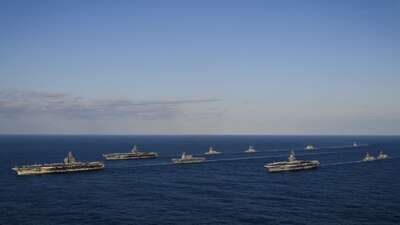By Air Force Tech. Sgt. Ryan Labadens, 403rd Wing
KEESLER AIR FORCE BASE, Miss., Nov. 13, 2017 — Air reserve
technicians, or ARTs, play a vital role in the Air Force mission to fly, fight
and win in air, space and cyberspace.
According to Col. Robert Stanton, 403rd Wing vice commander
and senior air reserve technician for the wing here, ARTs are Air Force
reservists who serve in a dual status for the Defense Department.
“It’s a full-time federal service position matched with a
military position, so it’s two positions under one title,” Stanton said.
“You’re only on one status at a time though, either as a civilian working 8
a.m. to 5 p.m. for example, or when you’re called up for duty -- you’re in a
military status.”
Identical Mission, Training Requirements
Just like traditional reservists, ARTs also participate in
unit training assemblies and perform annual tours alongside traditional
reservists, and are required to meet all of the same mission and training
requirements for their Air Force Reserve careers. The 403rd Wing currently has
379 members fulfilling these requirements.
However, one of the main differences between ARTs and
traditional reservists is that ARTs work as civilian employees during the week
to continue maintaining and operating their units between once-monthly weekend
unit training assembly, or UTA, weekends, Stanton said.
“The main thing the ARTs offer is stability,” said Stanton.
“It’s setting up the homefront, setting up the structure for the training
environment so that the traditional reservists who don’t work here full time
can just plug right in and get their training done.”
The ART program is also designed to offer a sense of
continuity between UTAs.
“We’re here to keep the mission going during the week when
the traditional reservists aren’t here,” said Air Force Senior Master Sgt.
Brett Blanchard, 403rd Wing force development superintendent.
Part of Blanchard’s responsibilities as a member of the 403rd
Wing education and training office is to help wing members apply for formal Air
Force schools and receive credit for higher education courses taken through
civilian universities, which can be applied as credit toward receiving their
Community College of the Air Force degrees. The office he serves in also helps
reservists to apply for tuition assistance through programs such as the GI Bill
and the Post-9/11 GI Bill.
“We can help them get the ball rolling for a lot of these
processes during the UTA, and then follow up during the week to make sure
everything is running smoothly and find out what else needs to be done to help
them accomplish what they want education wise,” Blanchard said.
Air Force Senior Master Sgt. Ingrid Anderson, 403rd
Aeromedical Staging Squadron medical technician, said the work her squadron
does during the weekend UTA flows right into the work week for the ARTs in her
squadron.
‘Our Job Never Stops’
“All the ARTs here have different roles in reference to what
they do as reservists, so our job never stops -- everything just flows
together,” said Anderson, who was hired as an ART to update and take care of
the medical requirements for 403rd Wing members. “So for example, we just came
out of the October UTA, and we just immediately started prepping for November
UTA.”
Of course, since the mission of the Air Force is to fly,
fight and win, the Air Force Reserve also seeks to hire ARTs who can help
maintain and fulfill that flying mission continuously throughout the year. The
403rd Wing has two flying squadrons: the 53rd Weather Reconnaissance Squadron
“Hurricane Hunters,” which flies the WC-130J Super Hercules, and the 815th
Airlift Squadron “Flying Jennies,” which flies the C-130J version.
Air Force Tech. Sgt. Jon Holderness is a member of the 803rd
Aircraft Maintenance Squadron. As a dedicated crew chief and ART with the unit,
Holderness said one of the main goals of ARTs, on the maintainer side, is to
train reservists to make sure their qualifications are up to date so they can
ensure the wing’s aircraft are ready to fly.
Holderness noted since ARTs make the Air Force Reserve their
full-time careers, this allows them to build up a wealth of experience to offer
to their units and the Air Force as a whole.
“This unit has a lot of experience in the weather
reconnaissance mission, a lot of experience with the tactical mission … so the
Air Force gets the benefit of that longevity and experience, which can stay
here at Keesler, but still be passed on to others so that these airplanes can
be well taken care of,” Holderness said. “My own training expertise increases
every year because I become more of an expert at giving that knowledge to the
younger individuals.”
For Holderness, being an ART also gives him the opportunity
to do something he loves full time -- working on aircraft.
“I love my job. This is what I wanted to do when I was a
kid, so working on aircraft is something I get to do as long as I want to,” he
said.








